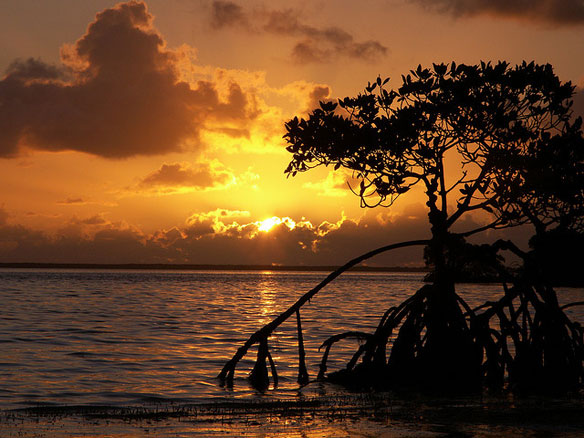
Mangrove trees, on Short Key, near Key Largo, Florida Keys. Photo source: ©© Monica R.
By NOAA,
NOAA scientists have found that pressure from increasing coastal populations, ship and boat groundings, marine debris, poaching, and climate change are critically threatening the health of the Florida Keys ecosystem. Many historically abundant marine resources such as green sea turtles and coral habitat continue to be at risk with low rates of recovery.
The findings were released today in the Condition Report 2011 for Florida Keys National Marine Sanctuary, describing the status and trends of the sanctuary’s water quality, habitats, and marine and cultural resources, and the human activities that affect them. This report is one of an ongoing series of condition reports for NOAA’s 13 national marine sanctuaries and Papahānaumokuākea Marine National Monument. It will guide a comprehensive review of sanctuary regulations and management plan beginning in 2012 and provide an important baseline on the status of sanctuary marine resources.
The report documents improvements in local water quality and an increase in the size and abundance of some fish species and spiny lobster in large reserves within the sanctuary, but also notes that challenges remain such as, addressing regional influences to water quality, human impacts on marine resources, and the effects of climate change. It further suggests additional efforts are necessary to support sustained management efforts, and increase regulatory compliance and community engagement to address those challenges.
“This report provides us with a great benchmark that can be used to protect our sanctuary’s valuable and productive marine ecosystem,” said Sean Morton, superintendent, Florida Keys National Marine Sanctuary. “The report also helps identify gaps in current monitoring efforts and highlights areas where we need additional information. Our long-term monitoring shows management actions are contributing to some positive results, however recovery of ecosystem health takes time.””
Since its designation in 1990, Florida Keys National Marine Sanctuary has worked with a wide array of local, state, and federal partners to promote conservation and sustainable use of the Keys ecosystem for future generations. These objectives are addressed through public education and research programs, the implementation of regulations including the prohibition of pollution discharge in sanctuary waters, and the designation of highly protected no-take marine zones to protect 6,000 species of marine life and reduce user conflicts. These efforts have been critical tools for natural resource management in the Florida Keys where ocean recreation and tourism supports more than 33,000 jobs, and accounts for 58 percent of the local economy and $2.3 billion in annual sales.
NOAA prepared the condition report in consultation with outside experts from the scientific community. The full report is available online at http://sanctuaries.noaa.gov/science/condition/fknms.
Florida Keys National Marine Sanctuary protects 2,900 square nautical miles of critical marine habitat, including coral reef, hard bottom, sea grass meadow, mangrove communities and sand flats.
Threats to Mangrove, Florida Keys, NOAA
Human activities such as dredging and careless boating are threatening South Florida’s mangroves and seagrass









